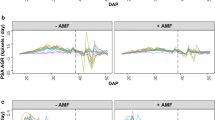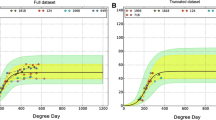Abstract
Plant growth modeling has attracted a lot of attention due to its potential applications. Many scientific disciplines are involved, and a lot of research effort and intensive computer methods were needed to understand better the complex mechanisms underlying plant evolution. Among the numerous challenges, one can cite mathematical modeling, parameterization, estimation and prediction. One of the most promising models that have been proposed in the literature is the GreenLab functional–structural plant growth model. In this study, we focus only on one of its versions, named GreenLab-1, particularly adapted to a certain class of plants with known organogenesis, such as sugar beet, maize, rapeseed and other crop plants. The parameters of the model are related to plant functioning, and the vector of observations consists of organ masses measured only once at a given observation time. Previous efforts for parameter estimation in GreenLab-1 include Kalman-type filters, stochastic variants of EM and/or ECM algorithms, and hybrid sequential importance sampling algorithms with Bayesian estimation only for the functional parameters of the model. In this paper, the first purely Bayesian approach for parameter estimation of the GreenLab-1 model is proposed. This approach has much more flexibility in handling complex structures, thus providing a useful tool for analyzing such types of models. In order to sample from the posterior distribution an MCMC algorithm is used and its implementation issues are also discussed. The performance of this method is illustrated on a simulated and a real dataset from the sugar beet plant, and a comparison is made with the MLE approach.






Similar content being viewed by others
References
Balakrishnan N, Ling MH (2012) EM algorithm for one-shot device testing under the exponential distribution. Comput Stat Data Anal 56(3):502–509
Barthélémy D, Caraglio Y (2007) Plant architecture: a dynamic, multi-level and comprehensive approach to plant form, structure and ontogeny. Ann Bot 99(3):375–407
Baey C, Mathieu A, Jullien A, Trevezas S, Cournède PH (2018) Mixed-effects estimation in dynamic models of plant growth for the assessment of inter-individual variability. J Agric Biol Environ Stat 23(2):208–232
Bertheloot J, Cournède PH, Andrieu B (2011) NEMA, a functional-structural model of nitrogen economy within wheat culms after flowering. I. Model description. Ann Bot 108(6):1085–1096
Brooks SP, Roberts GO (1998) Convergence assessment techniques for Markov chain Monte Carlo. Stat Comput 8(4):319–335
Celeux G, Forbes F, Robert CP, Titterington M (2006) Deviance information criteria for missing data models. Bayesian Anal 1(4):651–673
Chen Y, Trevezas S, Cournede PH (2015) A regularized particle filter EM algorithm based on Gaussian randomization with an application to plant growth modeling. Methodol Comput Appl Prob 17(4):847–870
Cournède P-H, Kang M-Z, Mathieu A, Barczi J-F, Yan H-P, Hu B-G, De Reffye Ph (2006) Structural factorization of plants to compute their functional and architectural growth. Simulation 82(7):427–438
Cournède P-H, Letort V, Mathieu A, Kang M-Z, Lemaire S, Trevezas S, Houllier F, de Reffye P (2011) Some parameter estimation issues in functional-structural plant modelling. Math Modell Nat Phenom 6(2):133–159
de Reffye P, Hu B, Kang M, Letort V, Jaeger M (2020) Two decades of research with the GreenLab model in Agronomy. Ann Bot 127:281
De Reffye P, Hu B-G (2003) Relevant qualitative and quantitative choices for building an efficient dynamic plant growth model: GreenLab case. In: International symposium on plant growth modeling, simulation, visualization and their, vol applications-PMA’0. Springer and Tsinghua University Press, pp 87–107
Gelfand AE, Smith AFM (1990) Sampling based approaches to calculating marginal densities. J Am Stat Assoc 85(410):398–409
Geman S, Geman D (1984) Stochastic relaxation, Gibbs distributions, and the Bayesian restoration of images. IEEE Trans Pattern Anal Mach Intell 6:721–741
Guo Y, Ma YT, Zhan ZG, Li BG, Dingkuhn M, Luquet D, de Reffye P (2006) Parameter optimization and field validation of the functional-structural model GREENLAB for maize. Ann Bot 97(2):217–230
Hastings WK (1970) Monte Carlo sampling methods using Markov chains and their applications. Biometrika 57(1):97–109
Jullien A, Mathieu A, Allirand J-M, Pinet A, de Reffye P, Cournède P-H, Ney B (2011) Characterization of the interactions between architecture and source: sink relationships in winter oilseed rape (Brassica napus L.) using the GreenLab model. Ann Bot 107(5):765–779
Kang MZ, Cournède PH, De Reffye P, Auclair D, Hu BG (2008) Analytical study of a stochastic plant growth model: application to the GreenLab model. Math Comput Simul 78(1):57–75
Loi C, Cournède P-H, Trevezas S (2011) Bayesian estimation in functional-structural plant models with stochastic organogenesis. In: Published in 14-th applied stochastic models and data analysis international conference
Meng X-L, Rubin DB (1993) Maximum likelihood estimation via the ECM algorithm: a general framework. Biometrika 80(2):267–278
Metropolis N, Rosenbluth AW, Rosenbluth MN, Teller AH, Teller E (1953) Equation of state calculations by fast computing machines. J Chem Phys 21(6):1087–1092
Roberts GO, Rosenthal JS (2001) Optimal scaling for various Metropolis–Hastings algorithms. Stat Sci 16(4):351–67
Sievänen R, Nikinmaa N, Nygren P, Ozier-Lafontaine H, Perttunen J, Hakula H (2000) Components of a functional-structural tree model. Ann For Sci 57(5):399–412
Trevezas S, Cournède P-H (2013) A sequential Monte Carlo approach for MLE in a plant growth model. J Agric Biol Environ Stat 18(2):250–270
Trevezas S, Malefaki S, Cournède P-H (2014) Parameter estimation via stochastic variants of the ECM algorithm with applications to plant growth modeling. Comput Stat Data Anal 78:82–99
Vos J, Evers JB, Buck-Sorlin GH, Andrieu B, Chelle M, De Visser PHB (2010) Functional-structural plant modelling: a new versatile tool in crop science. J Exp Bot 61(8):2101–2115
Yan HP, Kang MZ, De Reffye P, Dingkuhn M (2004) A dynamic, architectural plant model simulating resource-dependent growth. Ann Bot 93(5):591–602
Acknowledgements
We are grateful to the Editors and anonymous referees for their valuable feedback which improved the quality of our paper.
Author information
Authors and Affiliations
Corresponding author
Additional information
Publisher's Note
Springer Nature remains neutral with regard to jurisdictional claims in published maps and institutional affiliations.
Appendix
Appendix
The posterior density \(\pi (\theta , q_{0:N}| y_{0:N})\) of the model under the following prior distributions
can be expressed in the form:
A hybrid Gibbs sampler is used to sample from the aforementioned posterior distribution. A hybrid Gibbs sampler is a Gibbs sampler (Geman and Geman 1984, Gelfand and Smith 1990) where at least one of the direct simulations from the full conditional distributions is replaced by a Metropolis–Hastings step (Metropolis et al. 1953, Hastings 1970).
Let \(\pi (\theta , q_{1:N}|y_{0:N})\) be the density of the posterior (target) distribution with respect to some underlying measure \(\mu \) and \(\pi _i(\cdot |\cdot ), \ i= 1,\dots ,N+8\) be the full conditional distribution of the i component of \( {\mathbf {w}} = (\theta , q_{1:N})\). The hybrid Gibbs sampler simulates an observation of \({\mathbf {w}} =(\theta , q_{1:N})\) into \(N+8\) sequential steps by sampling from the full conditional distributions. In the case where direct sampling from \(\pi _i(\cdot |\cdot )\) is very difficult or even infeasible a MH step is incorporated into Gibbs sampler. The MH algorithm with proposal distribution \(p_i(\cdot |\cdot )\) generates a Markov chain with stationary distribution \(\pi _i(\cdot |\cdot )\). Thus, the Hybrid Gibbs sampler generates a Markov Chain through the following transitions.
It starts from the state \({\mathbf {w}}^0\) in the support of \(\pi \) and at time \(t+1\) gives \({\mathbf {w}}^t\) for \(i=1,\ldots , N+8\) proposes \(z_i \sim p_i(z_i|w_i^t)\) and set \(w_i^{t+1}=z_i\) with probability \(\alpha (w_i^t, z_i)\); otherwise, set \(w_i^{t+1}= w_i^{t}\) where
\(a(w_i^{t}, z_i)=\min \left\{ 1, \frac{\pi _i(z_i|w_1^{t+1}\dots w_{i-1}^{t+1}, w_{i+1}^{t} \dots w_{N+8}^{t})}{\pi _i(w_i^{t}|x_1^{t+1}\dots w_{i-1}^{t+1}, w_{i+1}^{t} \dots x_{N+8}^{t})}\times \right. \left. \frac{p_i(w_i^{t}z_i)}{p_i(z_i| w_i^{t})} \right\} \)
More specifically, the unobserved biomasses \(q_1,q_2,\ldots , q_N\) and the parameters \(\alpha _b\), \(\alpha _p\), \(p_p\) and \(\mu ^{-1}\) are simulated using Metropolis–Hasting steps. The remaining parameters of the model, \(\sigma _Q^2\) and \(\Sigma _Y\), are updated by using the corresponding full conditional distributions, since they have a known form. The specific sweep strategy for each scan (iteration) of this hybrid Gibbs sampler is described below in detail.
-
Step 1:
\(q_n,\ n=1,\ldots , N \ \hookrightarrow \) MH with target distribution the full conditional distribution of \(q_n\)
$$\begin{aligned}&\pi _n(q_n|\cdots ) \\&\quad \propto \prod _{i=n+1}^{(n+T) \wedge N}\big (1-\exp \left\{ -\delta \, s_{i-1}^{act}(q_n)\right\} \big )^{-1} \nonumber \\&\qquad \times \exp \left\{ -\frac{1}{2{\sigma _Q^2}}\left( \left( \frac{q_n}{F_{n-1}(q_n)}-1\right) ^2+ \sum _{i=n+1}^{(n+T)\wedge N}\left( \frac{q_i}{F_{i-1}(q_n)}-1\right) ^2\right) \right\} \nonumber \\&\qquad \times \exp \left\{ -\frac{1}{2}\sum _{i=(n-T+1)^{+}}^{n}(y_i-G_i(q_n))^{\top }\Sigma _{Y}^{-1}(y_i-G_i(q_n))\right\} , \end{aligned}$$and proposal distribution the one resulting from the prior transition kernel of the hidden chain under the current parameters’ values,
$$\begin{aligned} Q_{n+1}\sim {\mathcal {N}}_+(F_{n}\left( Q_{(n-T+1)^+:n}, E_{n}, \phi \right) , \sigma _Q^2 F_{n}^2\left( Q_{(n-T+1)^+:n}, E_{n}, \phi \right) ). \end{aligned}$$ -
Step 2:
\(\mu ^{-1}\ \hookrightarrow \) Random Walk MH with target distribution the full conditional distribution of \(\mu ^{-1}\)
$$\begin{aligned} \pi (\mu ^{-1}|\cdots )\propto & {} ({\mu ^{-1}})^N\exp \left\{ -\frac{1}{2 \sigma _{\mu 0}^2}\left( {\mu ^{-1}}-\frac{\mu _{\mu 0}}{\sigma _{\mu ^{-1}}^2}\right) ^2\right\} \end{aligned}$$where
$$\begin{aligned} \sigma _{\mu 0}^2= & {} \left( \frac{1}{\sigma ^2_{\mu ^{-1}}}\sum _{i=0}^{N-1}\frac{q_{i+1}^2}{c(i)^2}+\frac{1}{\sigma ^2_{\mu ^{-1}}}\right) ^{-1}\\ \mu _{\mu 0}= & {} \sigma _{\mu 0}^2 \cdot \left( \frac{1}{\sigma ^2_{\mu ^{-1}}}\sum _{i=0}^{N-1}\frac{q_{i+1}}{c(i)}+\frac{\mu _{\mu ^{-1}}}{\sigma _{\mu ^{-1}}^2}\right) \\ c(i)= & {} E_{i} \mu S_p\left\{ 1-\exp \left( -\,\frac{k}{e S_p}M_{i,b}^{act}(q_{0:i}, \phi )\right) \right\} \end{aligned}$$and proposal distribution of \({\mathcal {N}}_+(\mu ^{-1}_{old}, \sigma ^{2}_{\mu ^{-1}MH})\).
-
Step 3:
\(\alpha _b \ \hookrightarrow \) Random Walk MH with target distribution the full conditional distribution of \(\alpha _b\) and proposal distribution \({\mathcal {N}}(\alpha _{b-old}, \sigma ^{2}_{\alpha _bMH})\cdot {\mathbf {I}}_{(\alpha _b>1)}\).
-
Step 4:
\(\alpha _p \ \hookrightarrow \) Random Walk MH with target distribution the full conditional distribution of \(\alpha _p\) and proposal distribution \({\mathcal {N}}(\alpha _{p-old}, \sigma ^{2}_{\alpha _pMH})\cdot {\mathbf {I}}_{(\alpha _p>1)}\).
-
Step 5:
\(p_p \ \hookrightarrow \) Random Walk MH with target distribution the full conditional distribution of \(p_p\) and proposal distribution \({\mathcal {N}}_{+}(p_{b-old}, \sigma ^{2}_{p_pMH})\).
Since the functional parameters \(\alpha _b, \alpha _p, p_p\) appear in all densities functions of both the observed and hidden data, their functional form is complex and it is omitted here. The remaining parameters of the model are simulated directly from their full conditional distributions,
-
Step 6:
\(\sigma _Q^2\sim {{\mathcal {I}}}{{\mathcal {G}}}\left( \alpha +\frac{N}{2},\ \beta + \frac{1}{2}\sum _{i=0}^{N-1}\frac{\left( q_{i+1}-F_{i}\left( Q_{(i-T+1)^+:i}, E_{i}, \phi \right) \right) ^2}{F_{i}\left( Q_{(i-T+1)^+:i}, E_{i}, \phi \right) ^2}\right) \).
-
Step 7:
\(\Sigma _Y\sim {{\mathcal {I}}}{{\mathcal {W}}}(A +\Psi ,\ v+N+1)\)
where \(A= Y^* {Y^{*}}'\), and \(y_i^* = y_i - G_{i}(Q_{i:(i+T-1)},p_{al})\).
Since all the steps (steps 2–5) which involve Random Walk MH proposals concern unidimensional quantities, all the variances of the proposal distributions are selected in such a way that the corresponding acceptance probabilities are as near as possible to the optimal one which, in the univariate case, is 0.44 (see, e.g., Roberts and Rosenthal 2001). The initial variances that we used in the simulated and the real data cases in steps 2–5 of the proposed algorithm, common to all priors, are given below for reference:
Rights and permissions
About this article
Cite this article
Logothetis, D., Malefaki, S., Trevezas, S. et al. Bayesian Estimation for the GreenLab Plant Growth Model with Deterministic Organogenesis. JABES 27, 63–87 (2022). https://doi.org/10.1007/s13253-021-00468-w
Received:
Revised:
Accepted:
Published:
Issue Date:
DOI: https://doi.org/10.1007/s13253-021-00468-w




